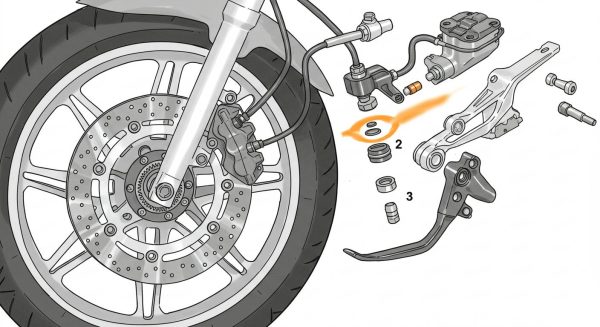Whether you’re operating a basic dual braking system motorcycle or one equipped with an advanced anti-lock braking system, mastering your machine’s stopping capabilities could save your life.
Understanding Modern Motorcycle Brake Systems
Today’s motorcycles typically feature a dual braking system, with independent controls for front and rear brakes. This dual system provides riders with precise control over their machine’s deceleration. Modern motorcycle brake systems are designed to provide optimal stopping power when both front and rear brakes are used in coordination.
Dual Braking System Techniques
In a dual braking system motorcycle setup, the front brake lever controls the front brake while the foot pedal operates the rear brake. The front typically provides 70-80% of stopping power, while the rear brake helps maintain stability and control. Learning to use both in harmony is crucial for effective stopping.
The Anti-Lock Braking System Revolution
The introduction of the anti-lock braking system in motorcycles has significantly improved rider safety. This sophisticated system prevents wheel lockup during heavy braking by automatically modulating brake pressure. Anti-lock braking systems are effective in emergency situations and challenging road conditions. Front wheel lockup when braking will cause a low-side accident when cornering – the front of the bike will ‘wash out’ and the rider falls to the inside of the curve. In a straight line, the front wheel will wash out to the side with the least resistance, and it’s almost impossible to recover from it. If the rear wheel locks up, the rider can easily maintain control in a straight line, but in a corner, the rear of the bike will swing out and could cause either a high-side or low-side crash.

How Anti-Lock Braking System Works
When you apply the brakes hard on a motorcycle equipped with an anti-lock braking system, sensors monitor wheel speed. If they detect an impending lockup, the system rapidly reduces and reapplies brake pressure. This process happens multiple times per second, helping maintain traction while allowing you to steer during heavy braking.
Maximising Your Motorcycle Brake System
Whether your bike has a basic or advanced motorcycle brake system, proper technique is essential. Start by applying both brakes progressively, gradually increasing pressure as the weight transfers forward. This approach prevents sudden weight shifts that could destabilise the bike.
Emergency Braking with ABS
On motorcycles with an anti-lock braking system, emergency stops require a different approach. You can apply maximum brake pressure quickly, as the ABS will prevent wheel lockup. However, remember that while anti-lock braking systems can help prevent skids, they don’t reduce stopping distances on dry, grippy surfaces.
Braking in Adverse Conditions
Your motorcycle’s brake system’s effectiveness can be significantly affected by weather conditions. In wet weather, even with an anti-lock braking system, you should:
- Begin braking earlier than usual
- Apply brakes more gradually
- Allow for longer stopping distances
- Be especially cautious on slippery surfaces
Maintaining Your Brake System
Regular maintenance is crucial for both traditional dual braking system motorcycles and those with anti-lock braking systems. Check brake fluid levels regularly, inspect pad wear, and ensure all components are in good condition. Any changes in brake feel or performance should be investigated immediately.
Practice and Skill Development
Mastering your motorcycle brake system requires regular practice. Find a safe area to practice emergency stops and progressive braking techniques. If your bike has an anti-lock braking system, familiarise yourself with how it feels when it activates so you won’t be surprised in an emergency.
Remember, while technology like anti-lock braking systems can help prevent accidents, they’re no substitute for proper technique and good judgment. Whether you’re riding a motorcycle with a basic dual braking system or one equipped with the latest anti-lock braking system, continuing to develop your braking skills is essential for safe riding.
By understanding and effectively using your motorcycle brake system, you’ll be better prepared to handle whatever situations arise on the road. Regular practice, proper maintenance, and awareness of your braking system’s capabilities will help ensure you can stop safely when needed.
